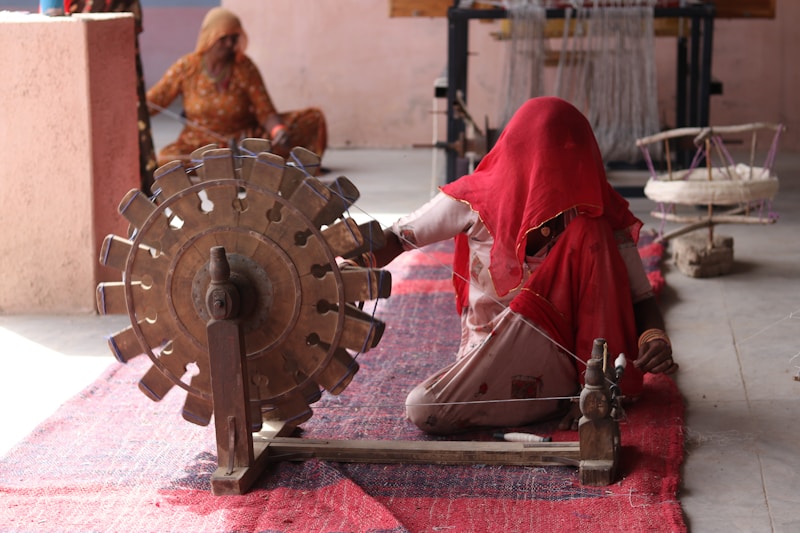Mahatma Gandhi’s birthday on the 2nd of October is celebrated as a national holiday in his native India.
We all know what this iconic figure looked like – unprepossessing, with his round glasses, traditional dhoti and kind eyes. But this one man did so much to change the world.
As we struggle to come to terms with the uncertainty of what the future will bring, his life and actions give us guidance and hope. And his values of tolerance, peace and standing up for what you believe in, are ones that we can all learn from.
His Early Life
The name he is known by – ‘Mahatma’ – means ‘Great Soul’ and was a name conferred on him by others as his fame spread. He was born Mohandas Karamchand Gandhi on the 2nd of October 1869 in Porbandar, Gujarat in north west India.
Born into a privileged Hindu caste, his father was the Chief Minister of Porbandar. He was brought up in a religious household, influenced by the Jain pacifist teachings that his mother adhered to.
At the age of just 13 years old he was married to Kasturba Makhanji, an arranged marriage, but one that would last until her death in 1944, and produced four sons.
At the age of eighteen, in 1888, Gandhi attended UCL in London to study Law and gain admission to the English Bar, where he also pursued the philosophical study of Hinduism, Christianity and Buddhism, laying the foundations for his life-long openness to other religions.
The Beginning of his Activism
In 1893 he accepted a year’s contract to work for an Indian Law firm in Natal, South Africa, and consequently lived there for the next twenty-one years. It was while living in South Africa that his anti-oppression politics began to emerge as he campaigned against the emerging injustice of the apartheid system.
The story goes that he was travelling by train in a first-class carriage and was asked to move to the third class area by the ticket inspector. He refused and was unceremoniously thrown off the train – sparking his outrage and fuelling his desire for change.
He founded a political movement while in South Africa called the Natal Indian Congress, and developed his belief in non-violent civil protest – opposing the introduction of registration for all Indians within South Africa.
His Return to Indian Politics
He returned to India in 1916 and by 1921 he was leading the Indian National Congress and his fame and political influence spread. His goal was ‘Swaraj’ or complete political independence from the British.
In March 1922 he was arrested on sedition charges and was imprisoned for two years of a 6-year prison sentence. This was for his encouragement of mass civil disobedience and the boycott of British goods and institutions. It was around this time that he chose to wear the simple ‘dhoti’ or loincloth. It is thought that he wanted to connect with the Indian masses.
In 1930 he went on a 250-mile march to the sea to collect his own salt, in protest against the British introduction of the salt tax. Gradually the British authorities began to recognise his national power and influence and began to negotiate with him, which in time led to the alleviation of poverty, granted status to the ‘untouchables’ (the lowest caste in the Hindu system), increased rights for women, and gradually, in 1947 to political independence from Britain.
Gandhi and Karma Yoga
Gandhi’s actions and efforts to peacefully bring India to independence saw him being nominated for the Nobel Peace Prize five times – although he never actually won it. The year he died, in 1948, no peace prize was awarded as there was no living person who deserved it.
He was a living, breathing embodiment of yoga, and specifically Karma Yoga, the yoga of action. He lived by the yamas and niyamas, with the most obvious one being ahimsa – non-violence. From his peace-loving childhood, he learnt that violence isn’t the only way to achieve seismic change.
He also had incredible tapas – persistence and zeal. Despite going to prison and suffering for the cause that he believed in, he continued to seek justice and independence for India.
His choice of the dhoti and his establishment of an ashram in 1915 demonstrated his aparigraha – or non-hoarding and rejection of materialistic values.
What Gandhi Can Teach Us
Steve Jobs wrote in Time:
He showed us a way out of the destructive side of our human nature. He demonstrated that we can force change and justice through moral acts of aggression rather than physical acts of aggression.
As humans, we have a tendency to be destructive – even if it’s just being self-destructive. We tend to look for the negative or think that we can’t change things for the better because that’s just the way things are.
Gandhi shows us that striving for change and justice is not only possible but possible – within a lifetime. As we face the trials ahead, we can bear in mind his commitment to alleviating the suffering of others, standing up for those that have the least, and giving a voice to those who are least heard.
How He Would have responded to the Pandemic
Gandhi was no stranger to plagues and epidemics. In fact, these shaped his life as an activist, and he would often fast during plagues in order to keep up his strength for his work (not sure how that worked!).
His grandson Rajmohan Gandhi said in an article, that Gandhi would firstly have thought of the neediest and most vulnerable and do his utmost to assist them.
He would have pointed out how the virus has reacquainted us with the certainty of death. And, with that, how it has reminded us of what is most important in life – ‘to not take our being alive, or our loved ones being alive, for granted.’
Finally, he would use the enforced lockdown as a way to muse on the shortcomings of our communities, and how to improve them.













